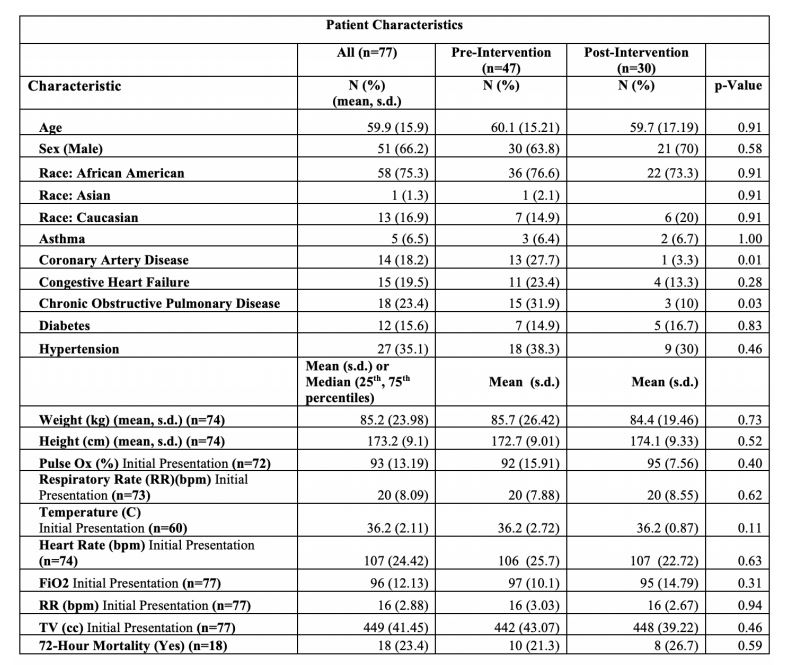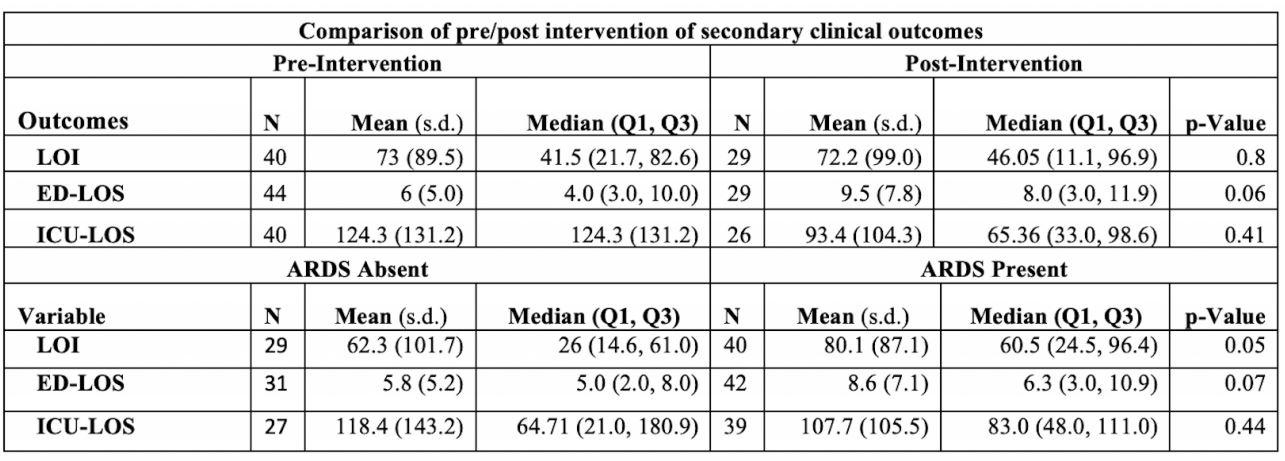Emergency Medicine and Trauma Care Journal
(ISSN 2652-4422)
Research Article
Lung-Protective Ventilation in the Emergency Department: A Quality-Improvement Study
Cibrario AM 1,2, Baker ZM 2,3, Min-Venditti 3C3,4, Vaizer J 2,5, Petrovich MP 2,6, Reed BP 2, Welch RD 2 and Jones KA* 2
1Department of Emergency Medicine, San Antonio Military Medical Center, USA
2Department of Emergency Medicine, Wayne State University, USA
3Department of Emergency Medicine, Greater San Antonio Emergency Physicians, USA
4Department of Emergency Medicine, Bon Secour Memorial Regional Medical Center, USA
5Department of Emergency Medicine, Indiana University School of Medicine, USA
6Department of Emergency Medicine, Adventist Health, Oregon Health and Science University, USA
*Corresponding author: Kerin Jones, Department of Emergency Medicine, Wayne State University, 4201 St. Antoine, 6F UHC, Detroit, MI, 48201, USA.
Citation: Cibrario AM, Baker ZM, Min-Venditti C, Vaizer J, Petrovich MP, et al. (2020) Lung-Protective Ventilation in the Emergency Department: A Quality-Improvement Study. Emerg Med Trauma. EMTCJ-100053
Received date: 09 November, 2020; Accepted date: 16 November, 2020; Published date: 23 November, 2020
Abstract
Background: Pulmonary complications develop in more than 20% of emergency department (ED) patients receiving mechanical ventilation. Use of lung protective tidal volume (TV) can reduce adverse outcomes such as acute respiratory distress syndrome (ARDS). We sought to determine the impact of an educational intervention on awareness of and adherence to ARDS network (ARDSnet) guidelines for TV settings and clinical outcomes.
Methods: This prospective observational study enrolled a convenience sample of patients > 18 years old requiring ED intubation and ventilation. ARDSnet-based educational interventions were provided. Awareness, defined as use of any predicted body weight (PBW) calculator and adherence, defined as use of correct PBW-based TV were compared pre-and post-intervention. Clinical outcome (development of ARDS within a 72-hour period) was determined.
Results: Enrolled were 47 pre- and 30 post-intervention patients. Awareness improved from 34.8% pre-intervention to 69.0% postintervention (difference 34.2%; 95% CI 12.4 to 55.9%; p = 0.004). Adherence to ARDSnet guidelines did not improve (71.7% preintervention to 82.1% post-intervention [difference 95%; CI -8.9 to 29.7%; p= 0.31]). There was no difference in the presence of ARDS between groups at 72-hours (p=0.29)
Conclusion: Awareness of ARDSnet guidelines improved with an educational intervention. Presence of ARDS between the pre- and post-intervention groups did not differ.
Keywords: ARDSnet; Emergency department ventilator settings; Lung protective ventilation; Tidal volume
Introduction
Acute respiratory failure is commonly treated in the emergency department (ED) and mechanical ventilation, when required, is often initiated in the ED. However, most of the research in this area has been done in the intensive care unit (ICU) setting. Since early post-intubation management can impact patients’ development of acute respiratory distress syndrome (ARDS) [1-6], it is important to initiate appropriate ventilator management in the ED. The goal of this study was to determine if an educational intervention could improve emergency medicine practitioners’ awareness of and adherence to ARDS network (ARDSnet) guidelines and if this translated into improved clinical outcomes.
Materials and Methods
This exploratory prospective observational quality improvement study was performed at a single urban level I trauma tertiary care center. Included was a convenience sample of patients > 18 years of age requiring intubation and mechanical ventilation (November 2017 to May 2018). Patients were excluded if they were pregnant, <18 years old, prisoners, enrolled in other clinical trials, had increased intracranial pressure, neuromuscular disease, sickle cell disease, acute congestive heart failure, severe chronic respiratory disease (FEV/FVC ratio <0.64), restrictive pulmonary disease (evidence on chest x-ray), pulmonary embolus, previous lung surgery, used immunosuppressive agents, or initially met ARDS criteria. The study was deemed exempt by the Wayne State University Institutional Review Board.
An educational intervention was provided to residents, attending physicians, respiratory therapists, and nursing staff that included a slide presentation summarizing the ARDSnet guidelines on predicted body weight (PBW), tidal volume (TV) settings, and recommends initial TV settings of 6-8 cc/kg based on PBW. A poster with ARDSnet PBW was placed in the resuscitation bay for reference. We considered the ARDSnet formula as best practice for determining initial TV settings, however, any recognized formula was accepted.
Primary Outcomes:
Secondary outcomes were development of ARDS up to 72-hours post-intubation and length of stay (LOS) metrics.
Initial ED visit patient information and care data was collected covertly by trained research assistants in a similar manner in both the pre- and post-intervention periods. Once enrolled, charts were reviewed for clinical course, length of intubation (LOI), length of stay in ED (ED-LOS), and length of stay in the intensive care unit (ICU-LOS).
Data Management and Analysis: Data abstraction was performed by trained study personnel and entered in the Research Electronic Data Capture (REDCap) tool [7-10]. Data obtained were baseline (immediately before and after ventilator placement in the ED) and at 72-hours post-presentation and included demographics, past medical history, presenting vitals, ventilator settings, and pertinent laboratory testing. Key outcome data were obtained throughout the 72-hour follow-up for total LOI, ED-LOS, ICU-LOS, and development and severity of ARDS based upon the ARDSnet definition. LOI and ICU-LOS were followed through the entire ICU stay.
For continuous data, means, medians, and an assessment of data spread such as standard deviation (s.d.) or percentiles), were calculated and graphically displayed (graphics not included here) to assess distribution patterns. Continuous data was compared using the two-sample t-test (normal distribution) or the Wilcoxon two-sample test (non-normal distribution) where appropriate. Categorical results were compared using Chi-Square tests or Fisher’s Exact test. All tests were two-sided and conducted at the significance level α = 0.05. Since there was no published data available and no agreed-on important effect size needed to calculate a sample size, this pilot observational study enrolled patients only during the pre-defined study period and will be used as the basis for future study.
Results
Forty-seven pre-intervention and 30 post-intervention patients were enrolled during the study. The two groups were similar except the pre-intervention group had more patients with coronary artery disease (p= 0.01) and chronic obstructive pulmonary disease (p= 0.03) (Table 1).
There was a significant improvement in awareness of ARDSnet guidelines after the educational intervention (34.8 % pre-intervention, 69.0% post- intervention, difference 34.2%, 95% CI 12.4% to 55.9 %; [p = 0.004]). Adherence to ARDSnet guidelines did not improve with educational intervention (71.7 % pre- versus 82.1 % post-intervention, difference 10.4%; 95% CI -8.9 to 29.7 %; [p=0.31] (Table 2). There was no significant difference in the secondary outcomes of LOI, ED-LOS, or ICU-LOS (Table 3).
Comparison of the presence of Acute Respiratory Distress Syndrome (ARDS) with length of Incubation (LOI), Length of stay in the emergency department (ED-LOS), and length of stay in intensive care (ICU-LOS).
Of the patients not meeting ARDSnet guidelines for TV settings, we found practitioners more often used TVs that were too low in both study arms. There were 13 patients in the pre-intervention group outside the recommended range; 9 (69%) below and 4 (31%) above. Among the patients in the post-intervention group, 5 were outside the range; all (100%) below recommended settings. This difference did not achieve statistical significance (p= 0.28). Finally, ARDS developed in 24 (55.8%) patients in the pre-intervention study period and 19 (44%) post-intervention (p=0.29).
Discussion
We found that an educational intervention defining appropriate TV settings in the ED improved awareness of ARDSnet guidelines but did not significantly impact adherence. Most initial TV settings, both pre- and post-intervention, met ARDSnet guidelines even if no PBW calculation was used. When the initial TV settings fell outside the 6-8cc/Kg PBW, the TV settings were more likely set too low versus too high. It was noted that those outside the range in the post-intervention group, all (100%) had TVs set too low (n=100%). Tidal volumes set too low have the potential clinical complications such as hypercarbia, acidosis or hypoxia [3,6,7]. Patients whose TV were set too high were more often found in the pre-intervention group 31% versus the post-intervention group 0%. Tidal volumes below recommended ARDSnet TVs in the post-intervention group may be due to increased awareness of deleterious effects of high TVs. The pre-intervention group’s settings below recommended TV is difficult to explain.
Follow up data showed no difference in the presence of ARDS between the pre- and post- intervention groups at 72-hours post-intubation. Patients with a longer ED-LOS also had a longer ICU-LOS and, though not statistically significant, possibly an increased incidence of ARDS. Several studies have demonstrated a prolonged ED length of stay has an association with worse patient outcomes including mortality [8,9].
A recent study concluded the use of lung-protective ventilation in the ED has important patient- and system centered positive outcomes including lower hospital mortality, decrease ARDS and lower hospital length of stay [9]. This supports prior studies showing clinical effect of initial ventilator settings selected in the ED on long term clinical outcomes of mechanically ventilated patients [10].
Study limitations include this was a single site quality improvement pilot study with a small sample size that did not include all potential subjects during all seasons of the year. There was also potential for the Hawthorn effect.
We concluded that an ED educational intervention on the ARDSnet PBW TV guidelines improved health care providers’ awareness of these guidelines but did not translate to increased compliance. Most initial TV settings met ARDSnet guidelines even if no PBW calculation was used. For patients with initial TV settings outside the guidelines, the majority were set too low. We found that an increased ED-LOS had an increased likelihood but not statistically significant of being diagnosed with ARDS at 72 hours.

Table 1: Patient Characteristics, past medical history, initial vital signs, initial ventilator data and 72 hour mortality. Standard Deviation=s.d.

Table 2: Awareness of Acute Respiratory Distress Network (ARDSNET) guidelines, defined as use of correct Predicted Body weight (PBW) Calculator to establish tidal volume (TV) settings and Adherence to ARDSNET guidelines, defined as initial TV set within appropriate range as established by ARDSNET guidelines (6-8cc/kg). Initial TV information was unavailable for two patients, resulting in N 46 of and N of 29, Pre and Post- Intervention respectively for the awareness group. Initial TV settings were unavailable for three patients, resulting in N=46 and N=28 Pre- and Post-Intervention respectively for Adherence.

Table 3: Comparison of pre-intervention and post-intervention length of Intubation (LOI), length of stay in the emergency department (ED-LOS), and length of stay in intensive care unit (ICU-LOS). Unable to compute LOI for eight patients, ED-LOS for four patients and ICU-LOS for 11 patients due to missing timestamps for relevant endpoints.
Citation: Cibrario AM, Baker ZM, Min-Venditti C, Vaizer J, Petrovich MP, et al. (2020) Lung-Protective Ventilation in the Emergency Department: A Quality-Improvement Study. Emerg Med Trauma. EMTCJ-100053